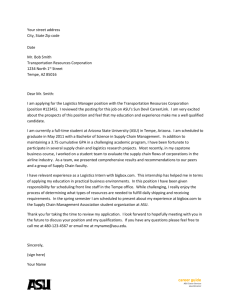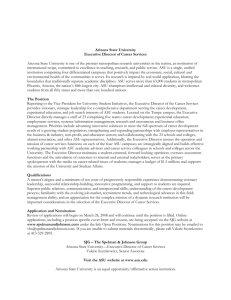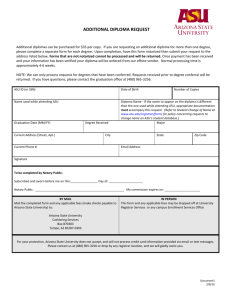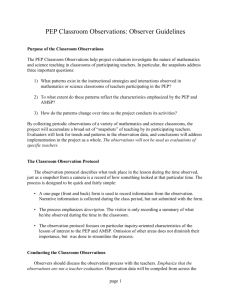Restructured master's degree program to accommodate PEP students
advertisement
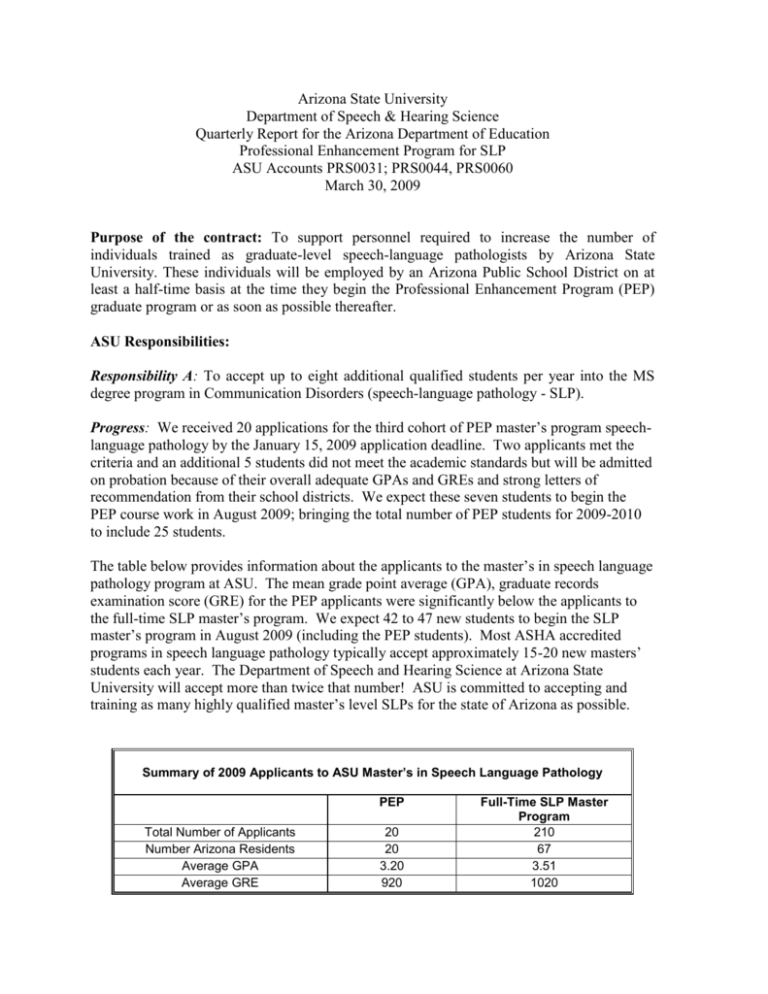
Arizona State University Department of Speech & Hearing Science Quarterly Report for the Arizona Department of Education Professional Enhancement Program for SLP ASU Accounts PRS0031; PRS0044, PRS0060 March 30, 2009 Purpose of the contract: To support personnel required to increase the number of individuals trained as graduate-level speech-language pathologists by Arizona State University. These individuals will be employed by an Arizona Public School District on at least a half-time basis at the time they begin the Professional Enhancement Program (PEP) graduate program or as soon as possible thereafter. ASU Responsibilities: Responsibility A: To accept up to eight additional qualified students per year into the MS degree program in Communication Disorders (speech-language pathology - SLP). Progress: We received 20 applications for the third cohort of PEP master’s program speechlanguage pathology by the January 15, 2009 application deadline. Two applicants met the criteria and an additional 5 students did not meet the academic standards but will be admitted on probation because of their overall adequate GPAs and GREs and strong letters of recommendation from their school districts. We expect these seven students to begin the PEP course work in August 2009; bringing the total number of PEP students for 2009-2010 to include 25 students. The table below provides information about the applicants to the master’s in speech language pathology program at ASU. The mean grade point average (GPA), graduate records examination score (GRE) for the PEP applicants were significantly below the applicants to the full-time SLP master’s program. We expect 42 to 47 new students to begin the SLP master’s program in August 2009 (including the PEP students). Most ASHA accredited programs in speech language pathology typically accept approximately 15-20 new masters’ students each year. The Department of Speech and Hearing Science at Arizona State University will accept more than twice that number! ASU is committed to accepting and training as many highly qualified master’s level SLPs for the state of Arizona as possible. Summary of 2009 Applicants to ASU Master’s in Speech Language Pathology PEP Total Number of Applicants Number Arizona Residents Average GPA Average GRE 20 20 3.20 920 Full-Time SLP Master Program 210 67 3.51 1020 Summary of 2009 Applicants (continued) Accepted Applicants Number expected to attend Number Arizona Residents Average GPA Average GRE PEP Full-Time SLP Master Program 77 35-40 24 3.75 1150 7 7 7 3.48 980 The Department of Speech and Hearing Science at Arizona State University is committed to addressing the shortage of speech language pathologists. ASU with the help from grants like this is able to training significantly more speech language pathologist for Arizona’s public schools. Where as most ASHA accredited University programs in speech language pathology accept an average of 15-20 masters students each year, ASU has admitted 30-35 students to the full time program each year and an additional 8-11 students to the PEP. The chart below indicates the number of new graduate students beginning the master’s SLP program each year at Arizona State University. New Students Accepted into the SLP Master’s Program Each Year at ASU 60 50 40 PEP 30 Full time 20 10 (e xp e ct ed ) 20 08 20 09 20 07 20 06 20 05 20 04 0 Responsibility B: To offer a graduate curriculum that provides students the opportunity to complete an MS degree in Communication Disorders in a 3-year period while employed in an Arizona public school. The curriculum will be comprised of academic coursework and clinical practicum experiences designed to satisfy the Knowledge and Skills required for certification by the American Speech-Language-Hearing Association (ASHA) as well as satisfying the requirements for a regular license as an SLP in the state of Arizona. Progress: The courses for the master’s degree in speech language pathology in the Department of Speech and Hearing Science at ASU are now offered in the evening beginning at 4:40pm. Most classes meet once per week so PEP students have two evenings each week where they are in class. There are two classes (out of 13 required courses for graduation) that currently are only offered Friday afternoons. An online course is being developed for SHS 575 Aphasia and Related Neurogenic Disorders since it can no longer be offered by the instructor in the evenings. This will allow the PEP students more flexibility with their class schedule during the fall semester of their second year. PEP students complete clinical practica in their district each semester, under the supervision of ASHA certified SLP in the district that the PEP student is employed. Supervisors of the PEP students were invited to join the ASU Cadre of Clinical Supervisors and a workshop was provided to all the supervisors in January to provide them with training on supervision and mentoring of graduate students in speech language pathology. The workshop was attended by 33 SLPs who were able to receive 3 CEU for their participation (see workshop brochure in Appendix A). The PEP coordinator has conducted regular visits to all of the public schools that the PEP students are providing speech and language services. Some PEP students have been visited more frequently because some districts have not been able to provide supervision often enough for students to obtained required ASHA clinical clock hours. The PEP students that are employed in the schools as Speech Language Pathology Assistants (SLPAs) have had the best access to training and mentoring. PEP students employed as Speech Language Technicians (SLTs) were responsible for their own caseload and had varied access to supervision and support. Some school districts hired master’s level SLPs for the sole purpose of supervising and mentoring the SLTs (PEP students). Other PEP students used their prep hours and release time to seek out supervision and support within their district for the practica. In addition, ASU has provided additional clinical supervision in the ASU Speech & Language clinic and at Banner Baywood Hospitals to provide clinical training in assessment and intervention of communication disorders in adults. This allowed the students in the full-time SLP masters program to acquire their adult clinical clock hours during the fall and spring semesters so that the PEP students will be able to acquired needed clinical training with adults during the summer sessions. Responsibility C: To advise and monitor the progress of PEP students as they matriculate through the curriculum. Progress: Our first two PEP students graduated with their master’s in speech language pathology on December 18, 2008! An additional two PEP students will complete their master’s in speech language pathology in August 2009 - one year ahead of schedule! The other cohorts of ASU PEP students completed the fall semester of course work with varied amounts of success. The demands of working and completing rigorous graduate classes were challenging for the PEP students. Regular study groups were offered to provide extra support as needed. Progress for the students enrolled in the Professional Enhancement Program (PEP) at Arizona State University is summarized in the table below. PEP Student Progress to Date Students Cohort 1 Started August 2007 2 transferred from ASU’s full-time Master’s program Expected Graduation (2) December 2008 Participating School District Mesa Creighton (2) August 2009 Scottsdale Deer Valley (6) May 2010 Washington Elem Mesa - 2 Kyrene Murphy Elem Roosevelt 9 PEP (began 8/08) Cohort 2 Started August 2008 Cohort 3 To start August 2009 9 PEP students (*11 accepted) 7 new PEP students expected to begin (1) May 2011 dismissed from program due to poor academic and clinical performance (8) May 2011 (1) dismissed from program due to poor academic and clinical performance (7) May 2012 Mesa Deer Valley Gilbert Mesa Queen Creek Scottsdale Washington Elem Washington Elem Peoria/Glendale Tollesin Gilbert Scottsdale 1 additional student has transferred from the fulltime SLP program to the (1) May 2010 Kyrene PEP * 1 moved out-of-state; another decided to continue working for a contract company rather than switch to work directly for a school district – direct employment by an Arizona school district is a requirement for the PEP Additional Activities Training for Clinical Supervisors in the Schools Other activities to increase the number of highly qualified SLPs in the Arizona public schools have been completed by the PEP coordinator and the faculty in the department of speech and hearing science. A “Cadre of Clinical Supervisors” was created to provide training, mentoring and support to speech language pathologists that supervise ASU SLP students completing internships in the public schools. Dedicated, highly motivated SLPs were recruited from school districts and hospitals/clinic settings throughout the metropolitan area to apply to become an ASU adjunct clinical faculty and member of the Cadre of Clinical Supervisors. We held two workshops, one in August 2008 and one in January 2009, for our Cadre of Clinical Supervisors (see workshop announcement in appendix A). We see benefits for our supervisors and our SLP students, including the PEP students. Students that work with the bright, energetic SLP in our Cadre of Supervisors are receiving state-of-the-art training in their school internships and seem more likely to seek employment in schools when they graduate. Internship Seminar: SLP Services in the Schools We have also continued a seminar, developed by the PEP coordinator, for all of our graduate students during the semester that they are completing their internship in the public schools. The seminar meets regularly throughout the semester and provides a forum for students to share ideas and discuss issues related to SLP services in schools. This seminar is another way of encouraging students in the full-time SLP master’s program to consider careers in the public schools upon graduation. The number of ASU graduates that take jobs in the public schools is summarized in Appendix B. ASU Job Fair in Speech Language Pathology The ASU chapter of the National Student Speech Language and Hearing Association held it’s annual SLP Job Fair on January 30th 2009. We had 35 companies participate including 20 school districts from across the state of Arizona. Undergraduate and graduate students at ASU were invited and approximately 65 master’s students in speech language pathology attended. It was a successful event to connect schools and future SLPs. Proposal and Development of a Certificate Program We are developing proposals for a certificate program to be offered to undergraduate speech and hearing majors during their junior/senior year. This certificate program would include additional clinical coursework and practica that would prepare the student with bachelors in speech and hearing to work in the public schools as a speech language assistant. This certificate program could also be available to students in another field who are interested in pursuing careers in speech language pathology. Commitment to Solutions to the SLP Shortage The Speech and Hearing Science Department at Arizona State University is accredited and ranked among the top 20 speech and hearing programs nationally. The number of undergraduate and graduate students continues to grow. The chart below reflects the growth from the last five years. With programs and partnerships like this one with the Arizona Department of Education, we are able to continue to train more SLPs to serve the children with special needs. 400 350 90 300 78 63 250 200 68 MS 66 BS 150 100 220 227 2005-06 2006-07 250 281 171 50 0 2004-05 2007-08 2008-09 Appendix A Supervisor Workshops Department of speech and hearing science Clinical Supervision in Speech Language Pathology August 9, 2008 8:30 – 3:30 Workshop Description This workshop will focus on the principles of clinical supervision for speech and language services and the importance of using evidence-based practice when training student clinicians. Requirements for supervision of speech-language master’s students and speech-language pathology assistants as outlined by the American Speech Language and Hearing Association and the Arizona Department of Health will be reviewed. Components of the supervisory process will be presented including planning, observing, analyzing and integrating components of the supervisory process. Research in supervision will be summarized. Learning Objectives Participants will be able to Identify the required amount of supervision for SLP student clinicians and SLP assistants Describe the supervisory process Analyze quality supervision Identify competencies essential to supervisory situations Complete a search of the literature to answer clinical questions using ASU’s online library service Presenters Dr. Shelley Gray is an associate professor of Speech and Hearing Science at Arizona State University in Tempe, Arizona. Her research focuses on early literacy development and assessment and treatment of language disorders in preschool and school age children. She has published extensively in this area and her research is currently funded by the National Institutes of Health and the U.S. Department of Education. Cathy Bacon is a clinical faculty member in the Department of Speech and Hearing Science at ASU. She coordinates the Professional Enhancement Program (PEP), ASU’s master’s degree program in speech/language pathology for professionals working or interested in working in the public schools. Cathy has been fortunate to provide clinical supervision to SLP students interested in working with children with communication disorders for over 15 years. CEUs ASU is approved by the Continuing Education Board of the American Speech-Language-Hearing Association (ASHA) to provide continuing education activities in speech-language pathology and audiology. This program is offered for 0.6 CEUs Intermediate Level, Professional Area. ASHA CE Provider approval does not imply endorsement of course content, specific products, or clinical procedures. Appendix A Supervisor Workshops Department of speech and hearing science Developing Clinical Competence: Tools for Supervision January 24, 2009 9:00am – 12:00pm Workshop Description This workshop will focus on strategies and tools for clinical supervision of students in speech language pathology. Information will be presented regarding the knowledge and skills required by the American Speech Language and Hearing Association for certification in speech-language pathology and the importance of clinical training and supervision for developing these skills. Research in supervision will be summarized and participants will learn how to help student clinicians identify goals and objectives for clinical practicum, provide feedback to student clinicians, and evaluate clinical performance. The use of Blackboard as a tool to share information with student clinicians and other supervisors will be demonstrated. Learning Objectives Participants will be able to Develop goals and objectives for student clinicians Identify strategies for providing feedback on therapy observations Describe the supervisory process Identify competencies essential to supervisory situations Access and post articles and forms for supervision on ASU’s Blackboard system Presenters Kelly Ingram is a clinical associate professor in Speech and Hearing Science and clinic director of the Speech and Language Clinic at Arizona State University in Tempe, Arizona. Her research and clinical interests include neurologically based communication disorders, and assessment and treatment of severe phonological problems. Kelly has published in these areas and regularly presents at state and national conferences and meetings. Cathy Bacon is also a clinical associate professor in the Department of Speech and Hearing Science at ASU. She coordinates the Professional Enhancement Program (PEP), ASU’s master’s degree program in speech/language pathology for professionals working or interested in working in the public schools. Cathy has been fortunate to provide clinical supervision to SLP students interested in working with children with communication disorders for over 15 years. CEUs ASU is approved by the Continuing Education Board of the American Speech-Language-Hearing Association (ASHA) to provide continuing education activities in speech-language pathology and audiology. This program is offered for 0.6 CEUs Intermediate Level, Professional Area. ASHA CE Provider approval does not imply endorsement of course content, specific products, or clinical procedures. Appendix B The chart below summarizes the percentage of students employed in different settings upon graduation. The blue bars and shaded blue bars reflect SLP graduates that are currently working in school settings either directly for a school district or for a company contracting SLP services to a school district. We will continue to track the number of ASU SLP graduates that accept jobs in AZ public schools. 50 45 40 35 30 Schools Contract Hospital Unknown 25 20 15 10 5 0 2003 2004 2005 2006 2007 2008
